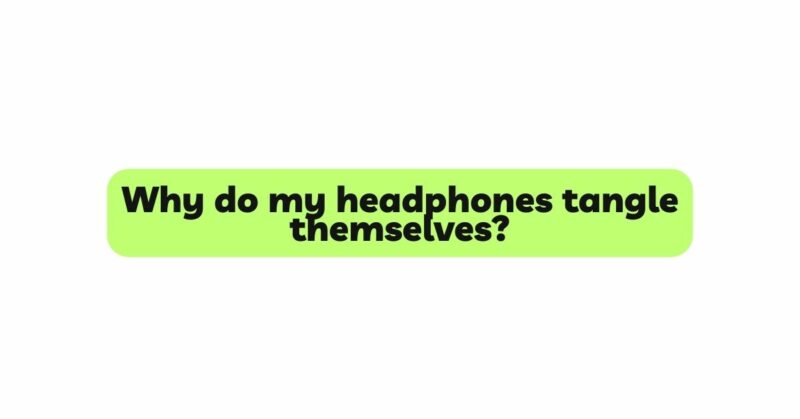The frustration of tangled headphone cords is a universal annoyance experienced by countless individuals worldwide. No matter how carefully we store them, it often seems that our headphones have a mysterious ability to entangle themselves within seconds. This article aims to unravel the enigma behind why headphones tangle themselves, delving into the scientific principles and human behaviors that contribute to this persistent and vexing issue.
- The Nature of Tangles:
Before we explore the reasons behind headphones tangling themselves, it is essential to understand what constitutes a tangle. A tangle occurs when a cord becomes twisted, interwoven, and knotted in a way that hinders its free movement or usability. Tangles can vary in complexity, ranging from simple knots to intricate, seemingly inextricable messes.
- The Physics of Tangle Formation:
The physics of tangle formation in headphone cords can be attributed to several factors, beginning with the flexibility and elasticity of the cord material. Most headphone cords are made from materials like rubber or plastic, which possess a certain degree of elasticity. When the cord is bent, coiled, or twisted, it stores potential energy. Upon release, this energy propels the cord to return to its original shape. These elastic forces can cause spontaneous knotting, even when the cord appears to be left undisturbed.
Another contributing factor is the phenomenon known as “self-entanglement.” Self-entanglement occurs when the cord undergoes random movements, such as bending, coiling, and twisting. These movements generate enough energy for the cord to intertwine and form knots.
- The Role of Mathematics in Knot Formation:
Knot formation has intrigued mathematicians and physicists for centuries, leading to its exploration within the field of topology. Topology is a branch of mathematics that deals with the properties of space preserved under continuous deformations, like stretching and bending.
Researchers have studied various types of knots and their behavior under different conditions, providing insights into their formation and behavior. While the mathematics involved can be complex, it offers a deeper understanding of the underlying principles behind tangle formation.
- The Influence of Human Behavior:
Tangle aggravation is not solely a result of physical factors; human behavior also plays a significant role. Actions such as carelessly stuffing headphones into pockets or bags contribute to cord tangling. Additionally, tugging or pulling on the cord when removing headphones from storage can worsen the situation.
Environmental factors also come into play. Cluttered spaces, such as bags or desk drawers, provide ample opportunities for cords to become entwined with other objects, further complicating the tangle.
- Prevention and Mitigation Strategies:
Though tangled headphone cords may seem like an inescapable inconvenience, there are several practical strategies to prevent and mitigate this issue. One approach is to invest in tangle-resistant headphones with flat or braided cords, as these are less prone to tangling. Some manufacturers have even introduced wireless headphones, eliminating cords altogether and providing a tangle-free listening experience.
For those who prefer wired headphones, cord management accessories can prove invaluable. Cord organizers, such as clips, winders, and ties, can help keep headphone cords neat and organized during storage and transportation. Properly storing headphones in dedicated cases or pouches also prevents tangling and protects them from damage.
- Understanding Human Habits:
Beyond the physical aspects of tangle formation, understanding human habits can lead to more effective prevention strategies. Studies have shown that humans have an inherent tendency to order and arrange things in patterns, including coiling and looping cords. This behavior often stems from a desire for tidiness and efficiency.
However, this organizational instinct can work against us, as we inadvertently create knots and tangles when trying to manage cords. By being aware of these tendencies, users can develop more conscious habits in handling their headphones, reducing the frequency of tangling incidents.
Conclusion:
The mystery of why headphones tangle themselves lies at the crossroads of physics, mathematics, and human behavior. The inherent flexibility of cord materials, coupled with random movements and user actions, creates an environment conducive to knot formation. The mathematical complexities of knots continue to intrigue scientists, providing valuable insights into the underlying principles of tangle formation.
Despite the challenge of tangled cords, numerous practical solutions and prevention techniques exist. Choosing tangle-resistant headphones, employing cord organizers, and cultivating conscious cord management habits can significantly reduce the frustration of tangled headphone cords. As technology continues to evolve, the option of wireless headphones offers a tangle-free listening experience for those seeking a cordless solution. By understanding the science and psychology behind tangled cords, we can navigate this common annoyance and enjoy a more seamless and tangle-free audio experience.


